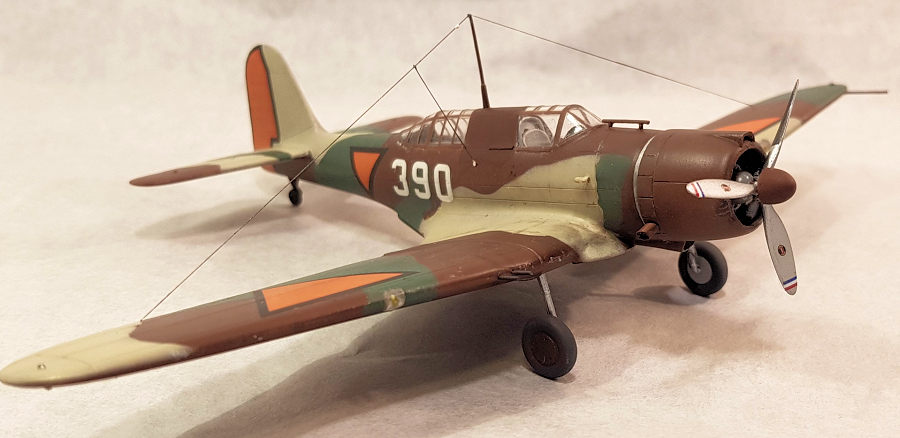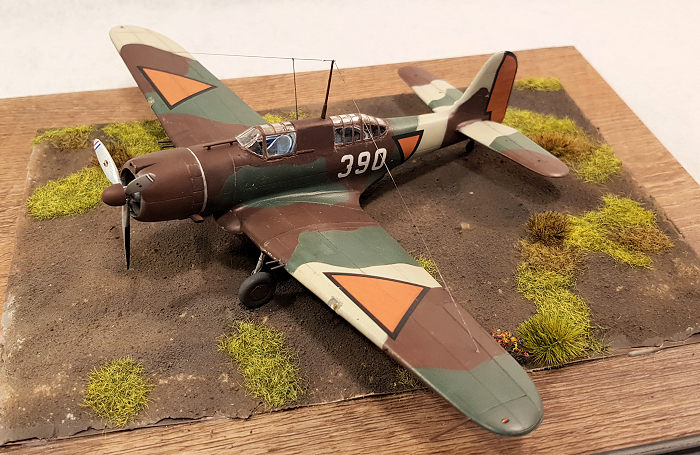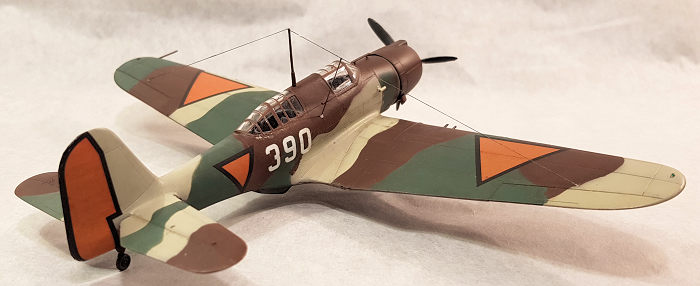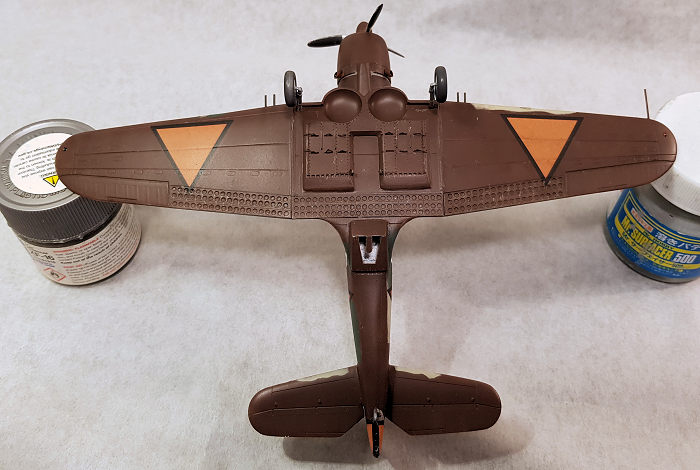
Special Hobby 1/72 Douglas DB-8A 3N
| KIT #: | |
| PRICE: | $18.00 |
| DECALS: | Four options |
| REVIEWER: | Fernando Rolandelli |
| NOTES: | 2023 edition |

| HISTORY |
 Derived
from a Northrop designed attack plane in service both in the USAAC as the A-17
and in many small air forces (including my country’s) in different versions with
different engines, armament and undercarriage configuration -usually in small
numbers-, the DB-8 3N was actually a competent ground attack machine for the
late 30s, when armor, self sealing tanks and anything bigger than a 0.303 was
kind of an excess. It even sported the highly efficient holed dive-brakes/flaps
that were later the hallmark of the SBD. It carried 600 kg bombs (two 300-der or
various arrays of smaller bombs) externally, had four (regarded) useful light
machine guns in the wings and another defensive facing rear, and a mostly
useless deployable observation/bomb aiming position in the rear underfuselage,
all at the very respectable speed of 416 km/h, all in the same class of any
light bomber of the era. Some versions like the Nomad or the Swedish Saab B-5
had more successful or at least peaceful careers.
Derived
from a Northrop designed attack plane in service both in the USAAC as the A-17
and in many small air forces (including my country’s) in different versions with
different engines, armament and undercarriage configuration -usually in small
numbers-, the DB-8 3N was actually a competent ground attack machine for the
late 30s, when armor, self sealing tanks and anything bigger than a 0.303 was
kind of an excess. It even sported the highly efficient holed dive-brakes/flaps
that were later the hallmark of the SBD. It carried 600 kg bombs (two 300-der or
various arrays of smaller bombs) externally, had four (regarded) useful light
machine guns in the wings and another defensive facing rear, and a mostly
useless deployable observation/bomb aiming position in the rear underfuselage,
all at the very respectable speed of 416 km/h, all in the same class of any
light bomber of the era. Some versions like the Nomad or the Swedish Saab B-5
had more successful or at least peaceful careers.
Bought by the Dutch in those incredible small numbers deemed enough in the 30s (36… geez, than would be lost in a day or two of operations) they were deployed in early 1940. The German offensive caught them without bombs, which the American company had incredibly not delivered yet, and therefore used as heavy fighter, being no less armed than most. Their only mission was made against Ju-52 transports and was moderately successful until escorting fighter arrived at the scene and made a butchery. “390” got a kill and managed to get back to his base, though.
| THE KIT |
Special Hobby issued this kit in his early days, say… 2003, in typical low run of the era. This reissue was most welcomed (at least by me) and included a resin “bomb carrier bed” which is prominent on the aircraft undersurfaces but was completely absent from the original issue; it also includes a minimal set of PE, mainly for the harness and bomb carrier. The limited run character is still very noticeable, as is the multi-version nature of the kit. There are several versions sporting the pre-war roundel, the prominent orange triangles and a captured German example. Seeing that discouraging double cockpit, I also bought their masks.
| CONSTRUCTION |
 Beginning
with the cockpit, I turned to the scarce period pictures of the machine, and
also to that of similar aircraft such as the SBD. The first challenge was the
colour. The Interior Green suggested was obviously wrong, so I resorted to plain
Aluminum as was the standard of the day. I added some fittings and structural
details, sparingly, considering the canopy would be necessarily closed. In
retrospect, the rear part was opened forward into the “solid” part, so it could
have been possible to mimick it as open. The rear gun was glued as stowed. With
everything checked, I closed the fuselage. In a most opportunity-lacking second
thought, I decided to open at least the space for the retractable underside
position, otherwise the window would reveal the fuselage. I did it with little
problem. I pondered adding SBD dive brakes in the open position, but none of the
various aftermarket types tried would fit exactly. Cowling/engine/intakes fit in
a rather strange way that requires care.. The fit of the clear parts (their
clearness exemplary) was generally good.
Beginning
with the cockpit, I turned to the scarce period pictures of the machine, and
also to that of similar aircraft such as the SBD. The first challenge was the
colour. The Interior Green suggested was obviously wrong, so I resorted to plain
Aluminum as was the standard of the day. I added some fittings and structural
details, sparingly, considering the canopy would be necessarily closed. In
retrospect, the rear part was opened forward into the “solid” part, so it could
have been possible to mimick it as open. The rear gun was glued as stowed. With
everything checked, I closed the fuselage. In a most opportunity-lacking second
thought, I decided to open at least the space for the retractable underside
position, otherwise the window would reveal the fuselage. I did it with little
problem. I pondered adding SBD dive brakes in the open position, but none of the
various aftermarket types tried would fit exactly. Cowling/engine/intakes fit in
a rather strange way that requires care.. The fit of the clear parts (their
clearness exemplary) was generally good.
The wings posed little problems. The bomb carrier is made in an extremely fragile resin and it is very easy to sand it too much; the various sway braces are intimidatingly small pieces of PE, but they were surprisingly well behaved (there are extra parts in case the carpet monster shows up). There are two leading edge landing lights completely blanked off; I rescued them with some clear styrene cut and sanded to shape. The undercarriage legs have that weird angle seen on SBDs, and the kit comes with just a plain guide to glue them; I laboriously holed both the legs and the recesses to fit some wire to act as pins.
With all this done (it sounds much easier and smoother than it was, it was a nightmare) I proceeded to paint the model.
| COLORS & MARKINGS |
 The
tri-colour Dutch camouflage is quite interesting, being a kind of unintentional
wrap-around camo. Some time ago, the colours were thought to be different, but
nowadays it is known (?) to be rather contrasting. I used Tamiya Dark Brown,
Deck Tan and Xtracolor FS34092. They fit exactly in the instructions’
illustration. The Aluminum ring behind the cowling I painted first and masked;
the tape was retired at the end of the painting and the result was surprisingly
good. Decals were perfect.
The
tri-colour Dutch camouflage is quite interesting, being a kind of unintentional
wrap-around camo. Some time ago, the colours were thought to be different, but
nowadays it is known (?) to be rather contrasting. I used Tamiya Dark Brown,
Deck Tan and Xtracolor FS34092. They fit exactly in the instructions’
illustration. The Aluminum ring behind the cowling I painted first and masked;
the tape was retired at the end of the painting and the result was surprisingly
good. Decals were perfect.
The undercarriage, after the work on the pins, went reasonably well, but had to be messed up to ensure the model sat squarely. The very common at the time wiring to the tip of the wings was prepared making small holes at the (seemingly) appropriate places; the tall antennae was also prepared with a wire pin and hole. The wire was made with fishing line, except the one to the fuselage that was stretched sprue.
| CONCLUSIONS |
Again, a model of a limited run kit of a limited used machine, one that fared worse than deserved by a mix of unpreparedness and detrimental circumstances. The camo is particularly attractive, and it is enhanced by the Orange triangles. I would very much like to see a mainstream kit in 1/48 scale.
| REFERENCES |
IPMS Nederland site (https://ipms.nl/artikelen/nedmil-luchtvaart/vliegtuigen-d/vliegtuigen-d-douglas-dc2-2?filter_tag[0]=)
11 February 2025
Copyright ModelingMadness.com. All rights
reserved. No reproduction in part or in whole without express permission from
the editor.
Review kit courtesy of my wallet If you would like your product reviewed fairly and fairly quickly, please contact the editor
or see other details in the
Note to
Contributors. Back to the Main Page
Back to the Review
Index Page
Back to the Previews Index Page